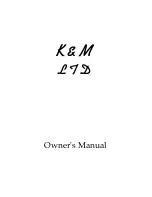
AMI Analyzer Manual
Maintenance and troubleshooting
32
Analyzer reads too high
1. Verify that there is no flow restriction in the vent line of the analyzer.
2. Increase the flow rate through analyzer by increasing the sample pressure - if the reading goes down it
indicates a leak in the incoming sample line or the cell block. Use “Snoop
” or equivalent to check all
the fittings back to the gas source.
3. Leak test all external fittings with “Snoop
” soap solution or equivalent.
4. Verify that the gas flow rate is correct. (0.1 to 2 SCFH)
5. Oxygen diffusion can be a serious problem. Verify that no plastic tubing or other plastic components
are used in a trace gas system, including diaphragms of pressure regulators, packing of valves etc. For
percent applications, similar problems may be experienced with silicone tubing. Use Teflon
or
Tygon
or similar high quality tubing.
6. Flow zero gas through the analyzer for a while until the reading is stable: shut off the incoming flow
with the sample/span valve and then immediately seal the vent tightly with a tube plug or equivalent
(don’t pressurize the cell!). Monitor the reading and see if it increases significantly over a 5 minute
period. Such an increase indicates a leak in the cell block or internal sample system.
7. Remove the cell and place it in a cell simulator and verify that the analyzer reads zero - if not, there is
moisture or corrosion between the sensor contacts in the cell block; clean the contacts and the area
around them with isopropyl alcohol, dry with dry compressed air or nitrogen, then replace the cap on
the cell block again. Pressurize the system to no more than 10 psig and leak check all the fittings and
tubing including the sensor block penetrations such as the sensor wire seals (nylon plugs and epoxy
seals on the top of the cell block).
NOTE: Be careful not to get soap solution on the PC boards!
NOTE: Almost always, high oxygen readings are due to leaks. Oxygen in the air is under a partial pressure
of about 5 psia at sea level, and thus will force its way into minute leaks, no matter what the internal
pressure of any other gas may be. 3000 psig nitrogen or other gas lines look like a vacuum to oxygen! This
always surprises people who have not experienced it.
Analyzer reads zero
1. Verify that the sensor is in the correct position, not upside down. If it is upside down, verify that the
membrane has not been punctured - i.e. there is no sign of electrolyte on the surface, and if not, put it
back the right way up. If you have left it this way for a while, it may take several hours to recover to a
low reading.
2. Verify that the cell block contacts are touching the sensor. Pull the sensor tab, and the contact should
hold the sensor with a gentle force. If not, the contacts may be bent. If they have been bent too much,
remove the sensor and gently bend them back so that they can again make contact.




































